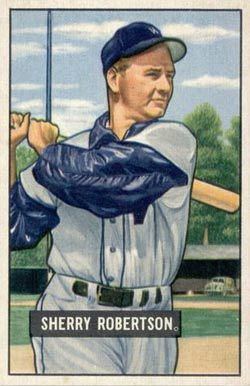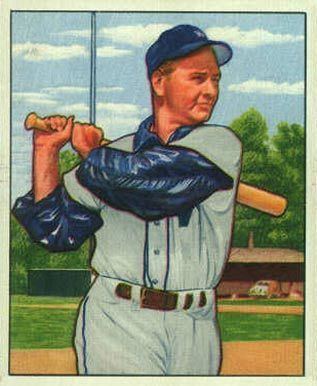Batting average .230 Role Baseball player Name Sherry Robertson | Runs batted in 151 Home runs 26 | |
 | ||
Died October 23, 1970, Houghton, South Dakota, United States | ||
Spring Fever Baseball 2016 - Max Kepler: Minnesota Twins
Sherrard Alexander Robertson (January 1, 1919 – October 23, 1970) was a Canadian-American outfielder, second baseman, front office executive and coach in Major League Baseball. The 6 ft (1.8 m), 180 lb (82 kg) (12 stone 12) Robertson batted left-handed and threw right-handed.
Contents
- Spring Fever Baseball 2016 Max Kepler Minnesota Twins
- Member of Griffith baseball dynasty
- Playing career
- Clash with Jeff Heath
- References

Member of Griffith baseball dynasty
The nephew of Baseball Hall of Fame pitcher, manager and club owner Clark Griffith, Robertson was part of an extended family that operated the Washington Senators/Minnesota Twins franchise of the American League for almost 65 years. Robertson was a native of Montreal, Quebec, the son of a minor league player; his father was Griffith's brother-in-law. Robertson moved to the Washington, D.C., area with his widowed mother and six siblings when he was a child. He attended the University of Maryland.
Robertson's brother Calvin was adopted by Clark Griffith, took his uncle's last name and succeeded him as the Senators' president. Calvin Griffith controlled 52 percent of the team's stock (evenly split with sister Thelma Griffith Haynes' 26 percent) and operated the Senators as majority owner from 1955–60. He then moved the club to Minneapolis–St. Paul after the 1960 season, and led the renamed Twins until he sold the club in 1984.
Sherry Robertson was the longtime director of the team's farm system, and two other brothers, Jimmy and Billy Robertson, were also club executives. In addition, brother-in-law Joe Haynes, a former Washington pitcher, was an executive vice president of the Senators and Twins; another brother-in-law, Joe Cronin, was a Hall of Fame shortstop who was player-manager of the Senators in 1933–34 (leading them to the 1933 AL pennant), manager and then general manager of the Boston Red Sox (1935–58), and president of the American League (1959–73); and at least two nephews, Clark Griffith II and Bruce Haynes, took active roles in managing the Twins' affairs.
Playing career
Robertson's playing career extended from 1939–52, with time out for service in the United States Navy in the Pacific Theater of Operations during World War II. He played for his brother Calvin with the Class B Charlotte Hornets in both 1939 and 1940 during Griffith's apprenticeship as a minor league manager.
Robertson saw MLB action with the Senators (1940–41, 1943 and 1946–52) and Philadelphia Athletics (1952). In ten seasons he played in 597 games and had 1,507 at bats, scored 200 runs, and compiled 346 hits, 55 doubles, 18 triples, 26 home runs, 151 runs batted in, 32 stolen bases, 202 walks, with a .230 batting average, .323 on-base percentage, .342 slugging percentage, 515 total bases and 14 sacrifice hits.
Robertson returned to uniform as a bench coach with the Twins in 1970. After that season, he died from injuries suffered in an automobile accident in Houghton, South Dakota, at the age of 51. He was elected to the Canadian Baseball Hall of Fame in 2007.
Clash with Jeff Heath
Robertson as an active player in 1946 had a brief but interesting experience with another ballplayer from Canada, Jeff Heath. Heath in his baseball career had good numbers and hit with power. He was physically very strong and a good athlete, but he was a bit of a trouble maker. In December 1945 he was traded from the Cleveland Indians to the Senators in exchange for very fast outfielder George Case and was Washington's starting right fielder, but in June 1946 the Senators sent him to the St. Louis Browns. After being traded to St. Louis, Washington writers commented about Heath's unwise riding of Robertson on the bench during games and calling him "owner's pet." This situation was disussed in a column after the trade by longtime Washington Post sports writer Shirley Povich. The sad part of the situation for Washington was that the Nats could have used Heath. With St. Louis the next year, he had a career high 27 home runs, but the Browns, always needing cash to operate, sold him to the Boston Braves after the 1947 season. He batted .319 with 20 home runs for the 1948 Braves as they won a surprise National League pennant, but Heath missed the World Series after severely breaking his ankle in a slide toward home plate in the last week of the season. A widely published newspaper photograph of the play showed Heath sliding toward the plate, mouth gaping in pain and shock, with his leg shattered mid-ankle. The lower ankle could distinctly be seen rotated ninety degrees to the upper ankle. Heath was never the same ball player afterwards.
